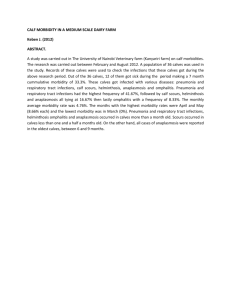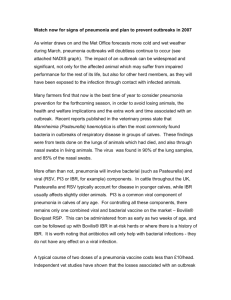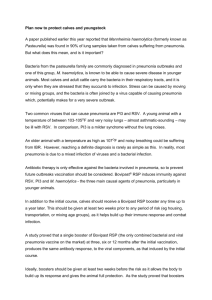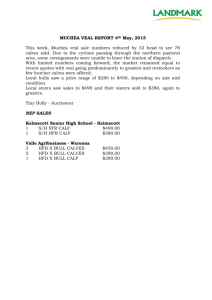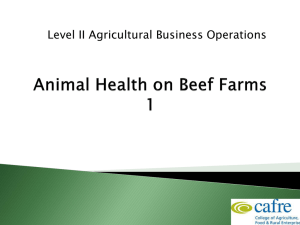Calf_Pneumonia
advertisement
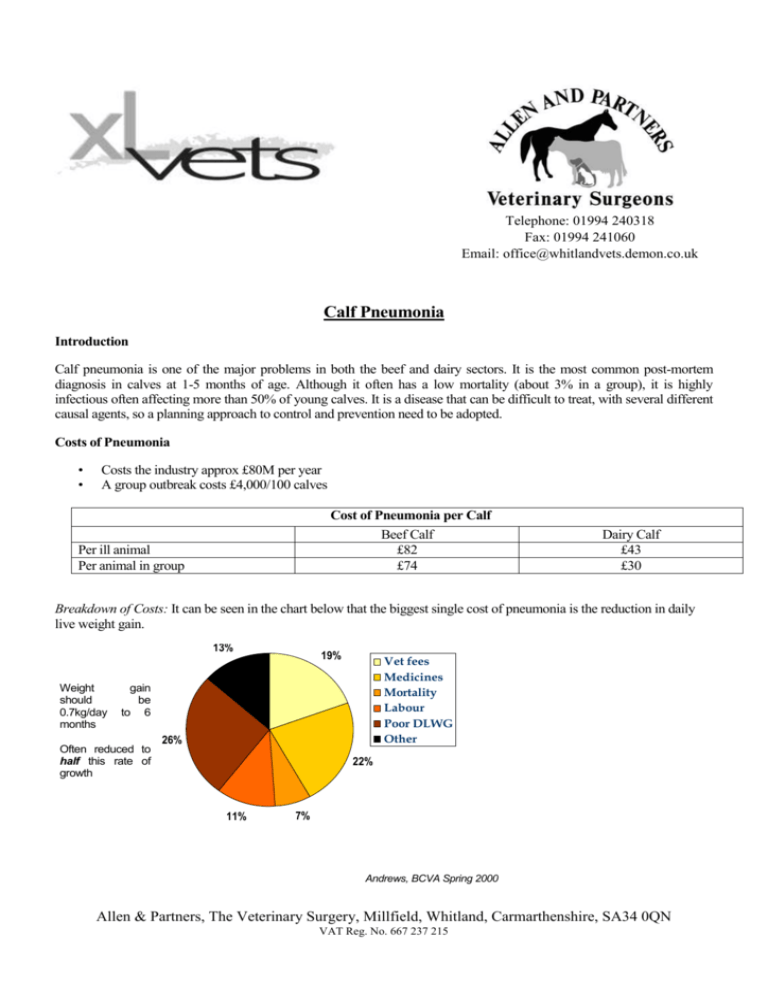
Telephone: 01994 240318 Fax: 01994 241060 Email: office@whitlandvets.demon.co.uk Calf Pneumonia Introduction Calf pneumonia is one of the major problems in both the beef and dairy sectors. It is the most common post-mortem diagnosis in calves at 1-5 months of age. Although it often has a low mortality (about 3% in a group), it is highly infectious often affecting more than 50% of young calves. It is a disease that can be difficult to treat, with several different causal agents, so a planning approach to control and prevention need to be adopted. Costs of Pneumonia • • Costs the industry approx £80M per year A group outbreak costs £4,000/100 calves Cost of Pneumonia per Calf Beef Calf £82 £74 Per ill animal Per animal in group Dairy Calf £43 £30 Breakdown of Costs: It can be seen in the chart below that the biggest single cost of pneumonia is the reduction in daily live weight gain. 13% Weight should 0.7kg/day months 19% Vet fees Medicines Mortality Labour Poor DLWG Other gain be to 6 Often reduced to half this rate of growth 26% 22% 11% 7% Andrews, BCVA Spring 2000 Allen & Partners, The Veterinary Surgery, Millfield, Whitland, Carmarthenshire, SA34 0QN VAT Reg. No. 667 237 215 Page 2 February 16, 2016 Signs of Pneumonia • • • • • • Dull & depressed, due to chest pain Raised temperature is an early indicator of pneumonia (>38ºC/103F) Raised breathing rate because of lung damage Reduced food intake. Remember other members of the group may eat the food left by sick calves. Nasal discharge. Coughing. Major Pathogens Initiating Pneumonia Viruses: RSV PI3 IBR Mycoplasma Bacteria: Mannheimia haemolytica (Pasteurella) Haemophilus somnus Lungworm NB only older animals at pasture Each of these pathogens needs a different approach to treatment and prevention. Risk Factors for Pneumonia The risk factors that are present at the start of a pneumonia outbreak need to be identified. An action plan then needs to be drawn up to help control the disease and plan for its prevention in the future. If the vet is only called in after the disease has been present for several weeks, there will already have been losses and the predisposing factors may no longer be present. The vet will then be reduced to providing a “fire brigade” service, which will do nothing to prevent disease in the future. These factors include: Mixing: Calves from different sources; calves of different ages Calves with older cattle Vaccinated and unvaccinated animals Sick with healthy calves Moving Within the same holding or from markets. Housing / Assembling of Groups: Housing from pasture Congregating around troughs or for shelter outdoors Poorly designed calf creeps Poorly designed buildings. The weather is often blamed for causing pneumonia when building design is the real cause. Poor Nutrition: Inadequate milk intake Mineral and vitamin deficiencies Weaning and other dietary changes Immunity: Decline in maternal derived immunity (colostrum). In a normal calf this lasts for 12 weeks. Page 3 February 16, 2016 Other diseases Calves that have had diarrhoea are 3 times more likely to get pneumonia Other stresses: Castration or dehorning etc. Treatment Antibiotics Many of the pathogens initiating pneumonia are viruses, antibiotics do not kill viruses. When treating virus pneumonia the antibiotics are used to control secondary bacterial infections, the virus infection will run its course. Not all antibiotics are effective against Mycoplasmas, so antibiotic choice is very important. A decision needs to be made to treat the whole group, or just those with a fever. Severely affected calves should be separated into a hospital pen. The antibiotics must be given for at least 3 days (this can be achieved using a long acting product). Identifying the cause of the pneumonia is essential in choosing the correct antibiotic treatment. Obtaining a diagnosis will save money in the long run. Anti-inflammatories (such as Flunixin). These drugs reduce the damage that an infection causes, including viruses. To be effective they need to be given early. Some products have antibiotics and anti-inflammatories together. Anthelmintics If older animals are coughing in the summer, they may have a Husk infection and will need worming. Husk can lead to a secondary bacterial infection. Anthelmintics are of no use in treating calf pneumonia in the winter. Control and Prevention Management Colostrum intake. The less the volume of colostrum, the less the protection. Other diseases. If BVD is present in the herd it will be causing problems, including an increased susceptibility to pneumonia Stress (e.g. castration and dehorning) should not be done at critical times such as weaning. Housing and ventilation. Every building has a limited number of animals it can house, but to maximise this, the ventilation needs to be designed correctly. A maximum group size of 20 calves, preferably with separate airspace Mixing. Never mix calves of different ages; from different management groups; calves with older cattle; bought in with home-bred; sick and healthy calves. Disease management. Recognise sick calves early, treat correctly, use hospital pens, consult the vet early. Vaccination There is no point in spending money on vaccination until the management issues have been addressed. Response to vaccination is poor if the immunity of the herd is reduced by BVD. Vaccination against BVD will help reduce general disease susceptibility. A vaccine can only protect against the pathogens that it is designed for. To choose a vaccine you need a diagnosis. Summary Pneumonia has different causal pathogens, it is not a single disease There are many risk factors A plan for treatment, prevention and control need to be specifically drawn up for each farm Acknowledgements XLVets best practice articles and presentations BVA “In Practice” articles BCVA “Cattle Practice” articles
